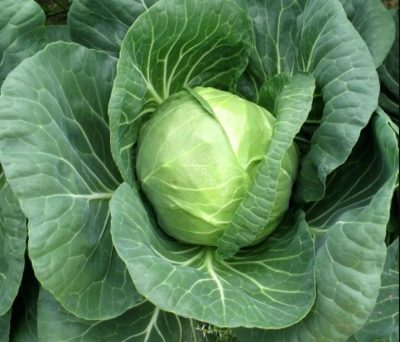
- Authors: Sakata Seed
- Name synonyms: Nozomi
- Year of approval: 2007
- Appointment: for fresh consumption
- Leaf rosette: raised to horizontal
- Leaf size: small
- Leaf color: gray-green
- Sheet surface: bubbly
- Outside stump: very short
- Internal stump: short to medium length
Nozomi is a Japanese-bred hybrid white cabbage, approved for use in 2007. This Asian guest is quite popular among Russian gardeners. Further in the article, we will learn more about all the features of this variety.
Description of the variety
The Nozomi hybrid quickly adapted to Russian conditions, but in some regions it needs to be grown indoors. Basically, the variety is recommended for cultivation in the North Caucasian and Lower Volga regions, as well as in the Central Black Earth Region. The fruits are highly marketable (90%), and also tolerate long-term transportation well, moreover, it is a high-yielding variety. All this makes it possible to grow Nozomi for industrial purposes.
Characteristics of the appearance of the plant and heads of cabbage
This variety is characterized by a rosette raised to the horizontal, small bubbly leaves with a wave along the edge, a very short outer stump and an inner stump of medium length. Heads of cabbage are small, compact, rounded, weighing about 1.3 kg, outside they are green, inside - yellowish. Their density is estimated at 4.5 points.
Purpose and taste
Consumers define the flavor of the Japanese hybrid as good and excellent. The texture of the vegetable is very delicate, therefore it is mainly used for fresh consumption.
Ripening terms
From the first shoots to the maturation of the heads of cabbage to the stage of technical ripeness, 103-130 days pass, which is typical for early-ripening varieties. It is customary to harvest in July and August. The nature of the maturation of the heads of cabbage is friendly.
Yield
This is a high-yielding variety, which on average is capable of producing 309-320 centners / ha of cabbage.
Growing and care
Sowing for seedlings is carried out in mid-March, and in mid-May, bushes can be planted in a summer cottage. For transplanting, choose a garden bed that is well lit by the sun. The place where legumes and cereals, cucumbers, pumpkins, onions, and root crops were grown are best suited. Ideally, prepare the land in the fall, for this they dig it up and add humus, compost and manure, and in the spring the site should be fertilized with potassium and phosphorus. The vegetable will grow more comfortably on fertile light loams.
Seedlings are planted according to the scheme 60x40 cm, by the time of transplanting, the sprouts already have 7-8 leaves and reach a length of 15-20 cm.They are planted in holes 15-20 cm deep, having previously placed humus, superphosphate, ammonium nitrate and potassium salt on the bottom. Seedlings are planted up to the level of cotyledon leaves, they compact the soil a little and moisturize the planting site well.
Follow-up care consists of regular and abundant watering. Each bush requires a portion of water in the amount of 2-3 liters. If the dry period has come, then the crop is irrigated at least once every two days. When the soil dries out a little, it should be loosened so that oxygen can freely penetrate to the roots of the plant, as well as weeds.
Two weeks after transplanting into open ground, the plant must be fed with mullein or chicken droppings, a liter of solution must be added under each bush.During the season, cabbage is fertilized two more times; complex mineral compositions are suitable as additional nutrition.

To grow a rich cabbage crop, you need to know when and how to plant this crop outdoors. Planting dates are determined depending on the variety. It is also necessary to properly prepare the soil and follow the rules of crop rotation.



Cabbage requires particularly careful care when growing. The plant quickly absorbs nutrients, so the soil needs to be enriched regularly. Adequate amounts of minerals, organics and nitrogen must be provided. Some products can be purchased at the store, while others are easy to make at home.
Disease and pest resistance
This exotic guest has a strong immunity to major diseases, it is resistant to bacteriosis and alternaria, and is almost not subject to cracking. However, sometimes the hybrid can be affected by keel, blackleg or downy mildew. To combat these ailments, use copper-containing preparations, such as Bordeaux liquid or lime solution. And also from these diseases will help "Fitosporin" or "Trichodermin".
Frequent enemies of the vegetable are the scoop, moth, cruciferous flea. Ash-soap solution, tobacco or dandelion infusion will help to cope with these parasites. Kinmix proved its effectiveness among the purchased drugs. Many diseases occur when the rules of agricultural technology are violated, therefore, as a preventive measure, observe crop rotation, do not ignore the rules of watering and feeding.

Cabbage is a very popular horticultural crop. But growing a good, large and tasty cabbage is sometimes very difficult, because it is often affected by a huge number of diseases and pests. The main role in the cultivation of this vegetable is played by regular prevention, which helps to get a rich harvest, and prevent the occurrence of diseases and the invasion of harmful insects. It is very important to start treatment as early as possible, otherwise there is a risk of spreading the infection to still unaffected plants.























































































